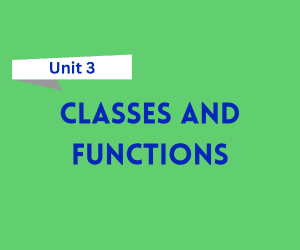
Free Download Classes and Functions Notes in pdf – Bca 4th Semester. High quality, well-structured and Standard Notes that are easy to remember.
Click on the Download Button 👇
Classes and Functions in Programming
Classes and functions are core components of modern programming, enabling developers to write modular, reusable, and organized code. While functions encapsulate a specific set of instructions to perform a task, classes provide a blueprint for creating objects, encapsulating data, and associated behaviors within an object-oriented paradigm.
Together, classes and functions improve code readability and maintainability, allowing programmers to build scalable and complex applications efficiently. These constructs are used across various programming languages like Python, Java, C++, and PHP.
Key Points
Functions
- Definition:
- A reusable block of code that performs a specific task.
- Purpose:
- Reduce redundancy by enabling the reuse of code.
- Structure:
- Typically includes a name, parameters, a body, and a return statement.
- Types of Functions:
- Built-in Functions: Predefined by the programming language (e.g.,
print()in Python). - User-Defined Functions: Created by developers for custom tasks.
- Built-in Functions: Predefined by the programming language (e.g.,
Classes
- Definition:
- A blueprint for creating objects, encapsulating attributes (data) and methods (functions) that define the behavior of those objects.
- Purpose:
- Support object-oriented programming (OOP) by modeling real-world entities.
- Structure:
- Includes attributes (variables) and methods (functions).
- Key OOP Concepts:
- Encapsulation: Bundling data and methods into a single unit.
- Inheritance: Deriving new classes from existing ones.
- Polymorphism: Allowing methods to have different implementations.
- Abstraction: Hiding implementation details and exposing functionality.
Features
- Code Reusability:
- Functions can be called multiple times, while classes can be instantiated into objects as needed.
- Modularity:
- Functions and classes divide code into smaller, manageable units.
- Encapsulation:
- Classes bundle data and methods, restricting direct access to some components to maintain integrity.
- Scalability:
- Classes and functions enable building large, complex systems by organizing code logically.
- Ease of Maintenance:
- Changes in one function or class don’t impact the rest of the codebase if designed properly.
- Inheritance and Reuse:
- Classes can inherit properties and behaviors from parent classes, reducing duplication.
- Extensibility:
- Functions can be expanded to include additional logic, and classes can be extended to support new functionalities.
- Improved Readability:
- Clear division of concerns through logical grouping of code.
FAQs
Q1: What is the difference between a function and a method?
A1: A function is a standalone piece of code, while a method is a function defined within a class and operates on an object.
Q2: Can a class have more than one constructor?
A2: Some languages like Python use a single constructor (__init__()), but others like Java or C++ allow multiple constructors via overloading.
Q3: What are static methods in a class?
A3: Static methods belong to the class rather than any object and can be called without creating an instance.
Q4: What is the purpose of a return statement in a function?
A4: It exits the function and optionally passes back a value to the caller.
Q5: How does inheritance work in classes?
A5: A child class inherits attributes and methods from a parent class, enabling code reuse and specialization.
Q6: Can a function return multiple values?
A6: Yes, some languages like Python allow functions to return multiple values using tuples, lists, or dictionaries.
Q7: What are abstract classes?
A7: Abstract classes cannot be instantiated and are used as blueprints for other classes, requiring derived classes to implement specific methods.
Q8: What is method overriding?
A8: It’s the process of redefining a method in a subclass that already exists in the parent class, allowing for customized behavior.